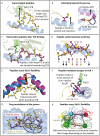Unconventional modes of peptide-HLA-I presentation change the rules of TCR engagement
- PMID: 38566908
- PMCID: PMC10917088
- DOI: 10.1093/discim/kyac001
Unconventional modes of peptide-HLA-I presentation change the rules of TCR engagement
Abstract
The intracellular proteome of virtually every nucleated cell in the body is continuously presented at the cell surface via the human leukocyte antigen class I (HLA-I) antigen processing pathway. This pathway classically involves proteasomal degradation of intracellular proteins into short peptides that can be presented by HLA-I molecules for interrogation by T-cell receptors (TCRs) expressed on the surface of CD8+ T cells. During the initiation of a T-cell immune response, the TCR acts as the T cell's primary sensor, using flexible loops to mould around the surface of the pHLA-I molecule to identify foreign or dysregulated antigens. Recent findings demonstrate that pHLA-I molecules can also be highly flexible and dynamic, altering their shape according to minor polymorphisms between different HLA-I alleles, or interactions with different peptides. These flexible presentation modes have important biological consequences that can, for example, explain why some HLA-I alleles offer greater protection against HIV, or why some cancer vaccine approaches have been ineffective. This review explores how these recent findings redefine the rules for peptide presentation by HLA-I molecules and extend our understanding of the molecular mechanisms that govern TCR-mediated antigen discrimination.
Keywords: T cells; antigen recognition; computational simulations; human leukocyte antigen (HLA); peptide presentation; protein flexibility.
© The Author(s) 2022. Published by Oxford University Press on behalf of the British Society for Immunology.
Figures


Similar articles
-
Specificity of bispecific T cell receptors and antibodies targeting peptide-HLA.J Clin Invest. 2020 May 1;130(5):2673-2688. doi: 10.1172/JCI130562. J Clin Invest. 2020. PMID: 32310221 Free PMC article.
-
T cell receptor interactions with human leukocyte antigen govern indirect peptide selectivity for the cancer testis antigen MAGE-A4.J Biol Chem. 2020 Aug 14;295(33):11486-11494. doi: 10.1074/jbc.RA120.014016. Epub 2020 Jun 12. J Biol Chem. 2020. PMID: 32532817 Free PMC article.
-
Impact of HLA-DR Antigen Binding Cleft Rigidity on T Cell Recognition.Int J Mol Sci. 2020 Sep 25;21(19):7081. doi: 10.3390/ijms21197081. Int J Mol Sci. 2020. PMID: 32992915 Free PMC article.
-
The Role of Molecular Flexibility in Antigen Presentation and T Cell Receptor-Mediated Signaling.Front Immunol. 2018 Jul 17;9:1657. doi: 10.3389/fimmu.2018.01657. eCollection 2018. Front Immunol. 2018. PMID: 30065727 Free PMC article. Review.
-
Immunogenic self-peptides - the great unknowns in autoimmunity: Identifying T-cell epitopes driving the autoimmune response in autoimmune diseases.Front Immunol. 2023 Jan 9;13:1097871. doi: 10.3389/fimmu.2022.1097871. eCollection 2022. Front Immunol. 2023. PMID: 36700227 Free PMC article. Review.
Cited by
-
RankMHC: Learning to Rank Class-I Peptide-MHC Structural Models.J Chem Inf Model. 2024 Dec 9;64(23):8729-8742. doi: 10.1021/acs.jcim.4c01278. Epub 2024 Nov 18. J Chem Inf Model. 2024. PMID: 39555889
-
Thioamide Analogues of MHC I Antigen Peptides.J Am Chem Soc. 2023 Nov 29;145(47):25559-25569. doi: 10.1021/jacs.3c05300. Epub 2023 Nov 15. J Am Chem Soc. 2023. PMID: 37968794 Free PMC article.
-
Closer Peptide Repertoire Similarity of HLA-B∗14:03 and HLA-B∗27:05 Sheds Light on Ankylosing Spondylitis Susceptibility.Mol Cell Proteomics. 2025 Jul;24(7):101008. doi: 10.1016/j.mcpro.2025.101008. Epub 2025 Jun 2. Mol Cell Proteomics. 2025. PMID: 40466865 Free PMC article.
-
Response to: Correspondence on 'H3.3K27M mutation is not a suitable target for immunotherapy in HLA-A2+ patients with diffuse midline glioma' by Chheda et al.J Immunother Cancer. 2023 Mar;11(3):e006784. doi: 10.1136/jitc-2023-006784. J Immunother Cancer. 2023. PMID: 36918223 Free PMC article. No abstract available.
References
-
- Gorer PA. The detection of a hereditary antigenic difference in the blood of mice by means of human group a serum. J Genet 1936, 32, 17–31.
-
- Horton R, Wilming L, Rand V, Lovering RC, Bruford EA, Khodiyar VK, et al. . Gene map of the extended human MHC. Nat Rev Genet 2004, 5, 889–99. - PubMed
-
- Rothbard JB, Gefter ML.. Interactions between immunogenic peptides and MHC proteins. Annu Rev Immunol 1991, 9, 527–65. - PubMed
-
- Guillet J-G, Lai M-Z, Briner TJ, Smith JA, Gefter ML.. Interaction of peptide antigens and class II major histocompatibility complex antigens. Nature 1986, 324, 260–2. - PubMed
-
- Davis MM, Bjorkman PJ.. The T cell receptor genes and T cell recognition. Nature 1988, 334, 395–402. - PubMed
Publication types
LinkOut - more resources
Full Text Sources
Research Materials
